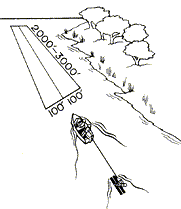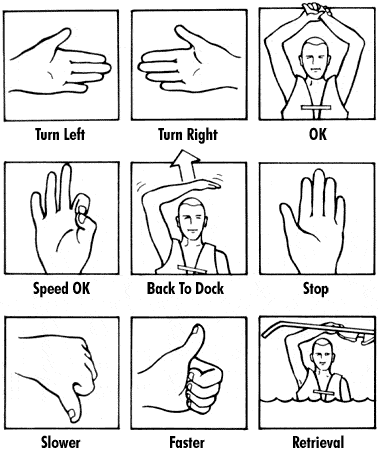Water-skiing is an exciting and challenging sport. However, like all “fast-action” sports that are fun, it does possess an element of risk. Many skiers and boaters are not aware of the potential hazards of water-skiing and as a result, are hurt or even killed pursuing this recreational sport. Attention to hazards in the area where you are skiing is especially critical due to the ever growing number of boats out on the water
Water skiing is a surface water sport in which an individual is pulled behind a boat or a cable ski installation over a body of water, skimming the surface on two skis or one ski.
 The Ski Area The size of the water area in which you intend to ski determines the number of boats and skiers that can operate within it at the same time. Each boat should be able to maintain a 200 foot wide “ski corridor” (100 feet on either side of the boat). The entire “skiing course” should be at least 2,000 – 3,000 feet long to avoid constant turning and risky maneuvering. A minimum depth of five to six feet of obstacle-free water is suggested for safe skiing to: (1) Keep the skis from dragging bottom during starts. (2) Allow for a margin of safety against hitting bottom or submerged obstacles during a fall
The Ski Area The size of the water area in which you intend to ski determines the number of boats and skiers that can operate within it at the same time. Each boat should be able to maintain a 200 foot wide “ski corridor” (100 feet on either side of the boat). The entire “skiing course” should be at least 2,000 – 3,000 feet long to avoid constant turning and risky maneuvering. A minimum depth of five to six feet of obstacle-free water is suggested for safe skiing to: (1) Keep the skis from dragging bottom during starts. (2) Allow for a margin of safety against hitting bottom or submerged obstacles during a fall
Serious injuries can result from hitting fixed objects such as docks, pilings or stumps. While many areas with obstacles are marked by warning buoys or signs, it is up to the boat operator, observer and skier to be alert to any potential hazards in the skiing area.
Avoid solid objects when landing. Many serious injuries occur when skiers attempt to stop near docks or pilings. Ski only in areas you are familiar with. Consult charts of the area, ask other skiers who possess “local knowledge,” and personally drive through the course before you actually ski it
As a rule, avoid skiing when the water is rough due to high winds. Choppy water demands a greater skill level and causes the skier to fatigue more quickly, often because the tow boat cannot maintain a constant sped. Skiing in the rain is not recommended because of the loss of visibility experienced by the boat operator.
When skiing in cooler weather, be aware of the effects of hypothermia. Loss of body heat leads to a reduction in coordination and judgment. The use of wet suits is an effective way to ward off the chilling effects of wind and cold water.
Safety Tips For Water-Skiers
Don’t take unnecessary risks while water-skiing. The following tips will help you safely enjoy this thrilling sport
- ALWAYS have an observer in the boat. This is a legal requirement in many states. The boat driver cannot watch the skier and operate the boat safely at the same time.
- ALWAYS wear a Coast Guard approved Personal Flotation Device (PFD) designed for water skiing. Ski belts are NOT recommended. Your approved PFD will help keep you afloat.
- Never ski in rough water. High waves or a choppy sea will prevent the tow boat from maintaining a steady course and speed.
- Stay well clear of congested areas and obstructions. Water-skiing requires a lot of open area.
- Don’t spray or “buzz” swimmers, boats, or other skiers. Such stunts are dangerous, discourteous, and could cause an unintentional collision.
- NEVER ski after dark. It is hazardous AND illegal. Any boat traveling fast enough to tow a skier is traveling too fast to navigate safely at night.
- NEVER water-ski while under the influence of alcohol or drugs. Such activity is extremely dangerous because of the impairment to your judgment and ability to respond. A recent study conducted with expert skiers who were deliberately intoxicated indicated that even their ability to ski was dramatically reduced.
- Use hand signals between the skier and observer. Agree before you start what each signal means so there is no confusion at a critical moment.
 Retrieving a Skier
Retrieving a Skier
Falling down in the water while water-skiing is a common occurrence, especially for beginners. If a skier has fallen or made a water landing, pick them up as soon as possible, since floating skiers are difficult for other boats to see. While waiting to be picked up, the skier should hold up a ski to increase their chances of being recognized in the water.
The boat operator reduces speed immediately while the observer maintains visual contact with the skier and directs the operator. Return to pick up the fallen skier with the boat at reduced speed and headed into the wind or current, whichever is stronger. Always turn off engine when approaching the skier.
The observer is to watch for the skier’s signal to indicate the skier is alright. If the signal is not seen, the operator must assume the skier is injured and needs immediate asistance. If the skier is injured but is able to grasp and hold a line, maneuver the boat upwind and close to the injured person. Turn off the engine, throw the injured skier a line and gently haul them in.
If they cannot grasp and hold a line, follow the same procedure, but let the boat drift towards them without power. Always keep the operator’s side toward the victim and NEVER retrieve anyone from the water with the engine running. Put a swimmer in the water to retrieve a skier only as a last resort.
Keep away from:
- Crowded Beaches
- Docks
- Swimming Areas
- Rocks and Bridge Pilings
